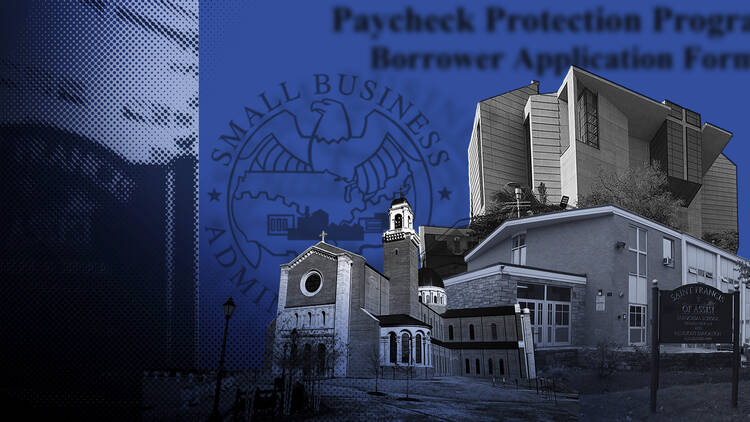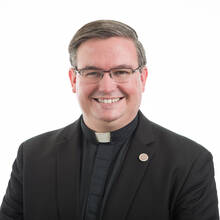The Associated Press is again reporting on beneficiaries of the Paycheck Protection Program within the U.S. Catholic Church. This story, framed the same way as its original reporting last summer, reads as though all the money—money intended to keep small businesses and nonprofits afloat amid the Covid-19 pandemic—was going to some centralized organization called “the Church.”
According to the report, “112 dioceses that shared their financial statements, along with the churches and schools they oversee, collected at least $1.5 billion in taxpayer-backed aid”—despite “sitting on well over $10 billion in cash, short-term investments or other available funds.”
It should be noted that these Catholic entities were well within their rights in applying for these funds, and in doing so achieved the very outcome envisioned by the program (that is, avoiding layoffs and a deeper economic downturn). Moreover, the report’s characterization hardly does justice to the diversity of the church, let alone to the many good works and dedicated employees the P.P.P. money is supporting. (Full disclosure: America Media applied for and was approved for a Paycheck Protection loan.)
This is so dumb. The Catholic Church is 1 billion people, 230,000 parishes, 150,000 schools worldwide.
— Jeremy Zipple (@jzipple) February 4, 2021
My parish, for example, is taking in a fraction of what we're spending on salaries for our 8 lay employees & for feeding 100+ desperate families our neighborhood https://t.co/FDVRT3fZzR
The assumption in these A.P. stories is that the church is primarily or only a self-interested institution composed of leaders motivated by power. The A.P. analysis suggests that the Catholic Church is just another rent-seeker in the U.S. political sphere: one more corrupt institution that the public cannot trust and the government should not fund.
But this kind of framing begs a fundamental question that deserves to be asked and answered: What is the Catholic Church?
The A.P. analysis suggests that the Catholic Church is just another rent-seeker in the U.S. political sphere: one more corrupt institution that the public cannot trust and the government should not fund.
Avery Dulles, S.J., offers another vision. In his book, Models of the Church, the Jesuit theologian presents six models, or paradigms, of how to view the church.
The first and most obvious model is the church as an institution. There are important ways in which the church can be understood institutionally. Most obviously, the ordered structure of doctrines, sacraments and “ministerial structures” help to unite diverse groups of Catholics in their common mission. In Jesus’ own time on earth, he established the Twelve Apostles, whom he instructed in ritual and prayer. Not much longer after Pentecost, the Twelve instituted seven men as the first deacons (Acts 6:1-7).
To the extent that the church is an institution, however, it “is not a monolith,” as America’seditor in chief, Matt Malone, S.J., wrote, but “a network of affiliated but legally and financially independent institutions. There isn’t a parish in the country that employs more than 500 people on its pastoral staff; and it is the parish, not the diocese, that has to make payroll for the parish staff each month.”
Viewed globally, the church is a multilayered, pluralistic constitution of the laity and priesthood, parishes, dioceses, episcopal conferences, religious orders and lay movements, ordinariates and personal prelatures, the College of Bishops, the College of Cardinals and, of course, the papacy. Not to mention the various charitable organizations that work through and with these entities, including schools, hospitals, homeless shelters and social services centers. However one breaks it down, it is misleading to suggest that one institution called “the Catholic Church” received $1.5 billion.
However one breaks it down, it is misleading to suggest that one institution called “the Catholic Church” received $1.5 billion.
More important, however, the church is not just an institution. To be sure, the institutional aspects of the church support the mission of the church, and they need to be held to account to do so. But the mission of the church is not to be an institution. The institutions “are second in the sense that they are intended to preserve and promote communion,” Dulles writes. Offices and ministries “are not ends in themselves” but are “to be exercised for the benefit of others, thus upholding the Church in its complex diversity and helping to build it up in its fundamental reality as a communion” (225). This is a point that Massimo Faggioli pressed ably in our print conversation about the papacy last year.
When we think of the church primarily or only as an institution, we run into some problems, like the assumptions that are embedded in the A.P. story. First, an institutional analysis of the church privileges governance in the church. But the church is not simply the hierarchy or priests, as we know. Every member of the church has a call to holiness, a call she lives out on earth through the church. In missing that, the A.P. story missed how much good the church is doing through its members. They missed stories like Fran Rossi Szpylczyn’s account of the good works her parish was able to continue to do thanks to the P.P.P. funds it received. As she wrote last summer:
“If this was all a money grab or a con to use funds for something nefarious, I cannot imagine how it would be done. Would it be better for our staff to go without pay and add to the current woes? Would it be better if we were not present to do God’s work? Given the great needs of our time, I am grateful beyond measure for the P.P.P. Along with the generous members of our community, it has kept us going.”
Second, an institutional analysis tends to treat the point of the church as self-preservation. But the church does not exist simply to preserve itself. When the church only worries about its self-preservation, its image, its prerogative, then it stops doing what it is supposed to do: spread the Gospel.
Pope Francis emphasized this point in his apostolic exhortation “Evangelii Gaudium” (“The Joy of the Gospel”):
“I dream of a “missionary option,” that is, a missionary impulse capable of transforming everything, so that the Church’s customs, ways of doing things, times and schedules, language and structures can be suitably channeled for the evangelization of today’s world rather than for her self-preservation” (No. 27).
This is the kind of self-gift undertaken freely by so many who received the P.P.P. money.
Third and finally, an institutional approach treats the primary dynamic of the church as power. Power matters, sure. But so does love, humility and mercy, which are ultimately grounded in God’s grace. Popular accounts of the church often look askance at the power of the church, skeptical of the ability of church leaders to use that power justly. Well, Catholics do, too; except they know that that is not the end of the story. The pope is at the top of the “power pyramid,” but more fundamentally he is a “loved sinner.”
Every member of the church has a call to holiness, a call she lives out on earth through the church. In missing that, the A.P. story missed how much good the church is doing through its members.
The A.P. asks questions about where federal dollars are going and how they are used. In fact, Catholics should be asking hard questions about how their parishes and dioceses are using federal funding. Good reporting could help them answer those questions. But the A.P. would have been better served asking how the individual programs and members of the church put the money to work at the service of mercy rather than assuming that the big, faceless “Catholic Church” used it for its own Machiavellian ends.
How, then, should we conceive of the church? Dulles offers five other models. The point of the models is not to find the one that is perfect but to see how each of them reveals something about the church. The one I want to focus on is as a “community of disciples,” a name taken from Acts 6:2. This is not the most theologically sophisticated model, but it speaks to a central experience of Christian life: a community united around fellowship with and in Christ.
At its most intense, such a community forms a “contrast society” of those who leave behind everything to follow Jesus, thus drawing in others by the scandal and mystery of their discipleship. Even when not exhibiting the “demanding and heroic character” of the apostles, this model of the church is deeply rooted in the figure of Christ. Disciples visibly represent Christ, and Jesus is really present in them: “He is constantly at work transforming the disciples into his image, claiming their lives for his service, empowering them for mission, and causing their labors to bear fruit.” This model ultimately “motivates the members of the Church to imitate Jesus in their personal lives.”
That imitation, of course, is at the root of the Gospel, the desire for which is a concrete experience of any Christian. Thus this model both speaks to our experience and challenges us to renew our commitment to that imitation.
The “community of disciples” model of church captures exactly what parishes, schools and other Catholic entities did with the P.P.P. money.
In short, the community of disciples captures exactly what parishes, schools and other Catholic entities did with the P.P.P. money. It reveals the church as consisting of more than just an elite, concerned with more than just its self-preservation, and motivated and guided by more than just power.
This model of the church might sound idealistic or naïve. After all, many Catholics would ruefully agree with the A.P. characterization of the church: an institution that is composed of leaders interested in self-preservation and motivated by power. No one can live through the clerical sex abuse, financial scandals and the sins of racism within the U.S. church and not pray for God’s mercy and the people’s conversion.
But the discipleship model does not erase the weaknesses and failures of Christians. Indeed, this is part of the strength of the model for Dulles: “Community of disciples, however, suggests that the Church is deficient, that it stands under correction, and calls for a personal response on the part of its members.” Humble imitation is a constant openness to conversion and a willingness to admit fault and seek reconciliation. The discipleship model is fundamentally aspiration: For the church to be a community of disciples means it must always strive to follow Jesus.
Whatever models we employ to understand the church today, we have to apply them critically: not only hermeneutically to explain how we are church but also prescriptively to show where we fall short of God’s kingdom. The cynical image that the world often has of the church can be all too real at times. We need models of the church rooted in Christ, ones that keep us from being what we can appear to be: a power-hungry elite who only serve their own purposes. Rather, as Pope Francis says: “The Lord’s disciples are called to live as a community which is the salt of the earth and the light of the world (cf. Mt 5:13-16). We are called to bear witness to a constantly new way of living together in fidelity to the Gospel. Let us not allow ourselves to be robbed of community!” (“Evangelii Gaudium,” No. 92).
Editors’ note: America Media applied for and was approved for a Paycheck Protection loan in the amount of $314,000.
More from America:
- Trailblazing Black Catholic geneticist wants more Black women to pursue careers in science
- After coup in Myanmar, Cardinal Bo calls for calm, release of prisoners and urges West to avoid sanctions
- Podcast: Pope Francis weighs in on divisions in the U.S. church
- Joe Biden calls out ‘political extremism’ at National Prayer Breakfast









